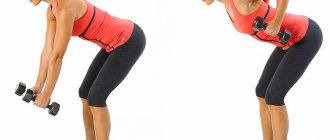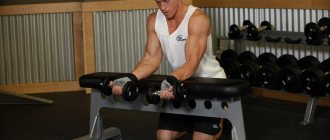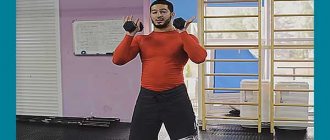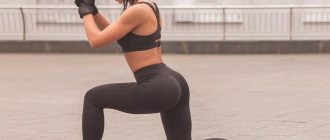Since dumbbells are enough to train your arms, you can pump up your biceps and triceps at home. The main thing is to pay attention to the muscles of the chest, shoulders and trapezius. Pumping them helps develop the upper body, making the figure more athletic.
In the material below you will find the best exercises for arm muscles that you can do at home or in the gym. With the help of the presented training program, you can both pump up your biceps a little and lay the foundation for moving on to more advanced training options.
Biceps: Introduction
Biceps are one of the favorite muscle groups of almost any bodybuilder.
Well, tell me: who hasn’t admired the size of Arnold Schwarzenegger’s biceps? Yes, almost every guy who comes to the gym. Why is this so important for a man? Perhaps this comes from the past, when strong hands helped our ancestors in hunting. The second is aesthetics, you will agree: strong hands make a man beautiful. By the way, according to various sources, the size of Arnold’s biceps was: 52-56 cm. Impressive, isn’t it?
Push ups
To achieve your goal, you can start doing push-ups. To pump up your biceps, you must follow certain rules for performing this exercise. Before you start making efforts specifically on the biceps, it is worth mastering the technique of classic push-ups. This point must be taken into account.
The biceps push-ups differ from the classic exercise in the position of the arms: the hands must be turned so that the fingers are pointing forward (as in the photo). It is this position that effectively influences the fact that the entire load is shifted towards working out the long head of the biceps. The whole point is not to spread your elbows out to the sides. The maximum development of the biceps is achieved when the chest touches the floor. Only with this implementation can you expect the desired result.
But it is also worth considering the fact that the tendons and joints of the hands are weakly strengthened. Therefore, you need to be extremely careful when performing the exercise. Painful sensations are guaranteed at first.
Basic biceps exercise
Reverse grip pull-ups are the only basic exercise for biceps.
What are the advantages? You can do it both in the gym and at home (if you have a horizontal bar, or in the yard if you have a crossbar). Why is it considered basic? Because you are working with your own body weight. As you progress, you can do pull-ups with weights.
It is very important to monitor the grip: the narrower the grip, the more emphasis we will work on the two biceps bundles rather than the latissimus dorsi muscles.
It is very important to include the biceps in the work in the process of lowering the body to the starting position. It is important to lower yourself smoothly as you inhale, keeping your elbows close to your body. Basic exercise must be included in your training program.
Horizontal bar
Some people don’t believe that the biceps muscle can really be pumped up with pull-ups. But this is true. This exercise is aimed at shaping the relief and developing strength in the hands of the trainee. Pull-ups do not result in muscle growth. However, with the correct technique, they can help you pump up your biceps on the horizontal bar. The training program should also include other exercises, such as push-ups. Pull-ups should be done like this:
- Use correct hand position. They should be placed at a distance of no more than 15 cm from each other. The palms should be directed towards the face, not away from you.
- Do not achieve the standard effect of pulling up - do not try to go as high as possible. Your task is to concentrate on the biceps. Feel the level of tension in the muscles at the moment of creating a right angle in the elbow joint.
- Try to feel your body - the level of your concentration on the exercise being performed depends on this. Don't do pull-ups automatically. Hold the air until your elbow is bent 90 degrees.
Biceps and isolation exercises
I guess I'll start with exercise as a priority.
Standing or sitting dumbbell curls
This is one of the priority exercises for working the biceps. Why dumbbells? In this exercise, you can stretch your biceps as much as possible through supination.
Be sure to choose a comfortable weight for yourself. Don't try to take multi-ton dumbbells and do the job dirty. Gradually increase the working weights from workout to workout.
Biceps brachii and hammer exercise
With a neutral grip, it is the brachialis that comes into play. This exercise also perfectly develops the forearm. You should also not use huge weights for this exercise. Focus on technique.
Standing barbell curl
An excellent exercise that works the long and short heads of the biceps, depending on the grip width:
- the narrower the grip, the more we load the long head;
- A wide grip loads the short head of the biceps.
The bar can be used either straight or curved. For progression, alternate the bars in your training cycles. Be sure to increase your working weight and keep a training notebook.
Lifting barbells or dumbbells on a Scott bench
I want to warn you right away that this is a traumatic exercise. Don't use heavy weights from the start. Be sure to learn the technique for performing this exercise. The peculiarity of this exercise is that you will get an exceptionally concentrated workout of the biceps. After all, in this simulator you turn off the muscles of the back and deltas.
Biceps curls on the lower block
An excellent exercise for working the biceps brachii muscle. You can use handles: straight or curved, as well as a rope. In this case, you should also not chase weight. Concentrate on technique for each exercise. Make a progression of loads with each workout.
In fact, these are not all exercises for biceps. But these exercises will be enough to introduce new things into your training and progress.
Concentrated lift
This is the name for isolation exercises aimed at working the biceps and brachialis muscles. Performing such lifts ensures:
- engagement of only one joint – the elbow;
- no need to use too large weights;
- visual division into two parts of the outlines of short and long beams, respectively.
Most often, such lifts are carried out in a sitting position. Technically it looks something like this:
- Place your feet shoulder-width apart.
- Take a dumbbell. With the same hand, place emphasis on the corresponding knee. If it is the right hand, then the knee of the right leg will be used as a support. It's all very easy to understand.
- Place your other hand (free) on your thigh. This way you will be able to fix yourself in a position that is comfortable for performing the exercise.
- Begin to slowly bend your arm at the elbow joint, lifting the dumbbell upward.
- Hold the projectile at the top point for a second or two and extend the elbow joint.
Such repetitions must be done for each hand 12-15, and approaches - 3 or 4.
Why don't my biceps grow?
There are quite a lot of reasons. Let's look at the main ones.
Exercising too often
If you think that the more often you train your biceps, the bigger they will be - no. The gym is full of such “personnel”. Previously, and maybe even now, they were called “snowdrops.” The type of guys who only trained biceps and abs. Do not expect biceps growth in this case: due to the state of overtraining, there will be no progress. It is also worth remembering that muscles grow during rest, not during training.
Poor nutrition
Perhaps this item will compete with the first for a leading position. The most common reason why your muscles aren't growing is because you don't eat enough. How can muscle tissue be built without the proper amount of proteins, fats and carbohydrates? That's right, no way. You don’t have to eat with pots and pans; make a smart meal plan. Snickers, chips, Fanta - tasty, but useless for creating titanium arms.
Need a meal plan to suit your goal? Write through contacts or messengers.
Worse than incorrect technique is monotony of exercises.
Be sure to learn the technique for each exercise you plan to do. Alternate exercises during your workouts. Alternate dumbbells/barbells.
Bad genetics
This is a factor that should frustrate a professional bodybuilder. The average person is capable of building voluminous biceps, but it takes effort. In bodybuilding, the main thing is discipline both in training and in life: proper nutrition and recovery.
How often should you train your forearms?
I have often heard the opinion that the forearms need to be trained often, because... they are very durable due to the fact that they are constantly used throughout the day.
I don't agree with this.
All the movements we perform with our forearms every day are very low volume and low intensity.
Well, let’s say, hold a spoon, click on the keyboard, carry packages from the store. Actually, that's all.
For such movements, it is quite possible to use cheaper methods of energy supply, which is what our body does.
When we begin to specifically train our forearms with apparatus in the gym, our load turns into a narrowly focused one, unfamiliar to our forearm muscles.
I don't see any special program for training the muscles of the forearms. They also obey the same rules of growth as other muscles:
- PROGRESSION OF LOAD (the volume of training should increase). Perhaps the main rule, because THERE IS NO SENSE FOR MUSCLES TO INCREASE IF THE LOAD DOES NOT INCREASE.
- THE LOAD MUST HIT EXACTLY ON THE TARGET (you need to learn to feel the muscles you want to develop).
- NECESSARY RECOVERY (small meals 6-12 times a day + sleep 8-10 hours).
The forearms are smaller than all other muscle groups, so they can recover a little faster, in theory. But in practice, no one trains the forearms more often than all other muscles.
Most professionals don't train their forearms at all, because... they get enough exercise on biceps training day.
Conclusion: We train the forearms with the same frequency as all other muscle groups. More often it’s not worth it, less often it’s possible.
The number of repetitions for the forearms should be slightly higher than for other muscle groups, because the AMPLITUDE OF MOVEMENT is much smaller!
Compare the range of motion when doing squats (roughly speaking, half of the body needs to bend) and when doing barbell curls. The difference is huge!
The number of repetitions is not as important as the time the muscle is under load.
Muscle failure should occur within 15-35 seconds of starting the set. That’s why, in training your forearms, in each approach you will have to perform a slightly larger number of repetitions than usual (you, in the same time, can do more wrist curls than squats or barbell presses, that’s all).
Typically, you will need to perform 10 to 20 repetitions.
Conclusion: when training forearms, we work in a slightly larger repetition range, about 10-20 times in one approach.
Workout plan for growing biceps. Creating Titan Arms
If you train three times a week in splits: chest and biceps, back and triceps, shoulders and legs, try this workout option:
Monday (chest and biceps)
- Warm up 10-15 minutes
- Bench press on a horizontal bench 4 sets and 10-12 reps
- Incline Press 3-4 sets 8-12 reps
- Butterfly trainer
- Pull-ups on the horizontal bar with a reverse grip, do 3 approaches for the maximum number of times
- Hammer exercise 4 sets 12-15 concentrated lifts
- Lifting dumbbells on a Scott bench 3-4 sets of 10-15 reps
- Ab exercises 3 sets
- Hitch
Alternate biceps exercises every week: replace dumbbells with a barbell (or vice versa), change the order of the exercises themselves. Progress in weights - this is a direct requirement.
Wednesday (back and triceps)
- Warm up 10-15 minutes
- Wide grip pull-ups 4 sets for as many reps as possible (if you are not using extra weight)
- Deadlift 3-4 sets 8-12 reps
- One-arm dumbbell rows 3-4 sets 12-15 reps
- French press 4 sets 10-12 reps
- Dips 3-4 sets for maximum reps (if you are not using additional weight)
- Extensions on a block 4-5 sets 12-15 reps
- Ab exercises 3 sets
- Hitch
Be sure to alternate back and triceps exercises every week. Create dynamics of working scales.
Friday (shoulders and legs)
Regarding shoulders: the best workouts for growing shoulder muscles, I recommend reading.
- Warm up 10-15 minutes
- Standing/seated dumbbell press 3-4 sets 8-12 reps
- Alternately lifting dumbbells in front of you 3-4 sets 12-15 reps
- Dumbbell lateral raises 3-4 sets 10-12 reps
- Butterfly raises 3-4 sets 8-12 reps
- Back squats 4-5 sets 10-12 reps
- Leg press 3-4 exercises 3-4 sets 10-15 reps
- Leg bending/extension on the machine 3-4 sets 10-15 reps
- Hitch
Just like shoulder exercises, leg exercises must be changed and alternated with each workout. Be sure to increase working weights.
Weight
You can do more than just dumbbell work and pull-ups. Kettlebell exercises for biceps are also very effective. There are a number of powerful exercises aimed at pumping the biceps muscle with the help of this unique projectile.
The principle of working with a kettlebell is based on the already described variants of exercises performed with dumbbells. Only here you will not make simultaneous movements with both hands. In this case, the entire emphasis is on alternately pulling the same weight with different hands. The exercises are performed as follows:
- Lifting the weights up in a sitting position.
- Bend the torso to the sides.
- Lifting weights in a standing position.
- Lifting a projectile from the floor with force onto the chest in a standing position.
When performing the listed complex exercises, you must remember about proper breathing. When lifting the projectile, you should always exhale, and when lowering, inhale. A lot also depends on breathing, so it makes sense to follow the technique in detail.
Working with an expander
A super-hard expander is used, exercise with which is a good alternative for regular home workouts to develop this muscle group. A soft projectile is used mainly for working on the hand, so in this case it is important that it be hard. It is also recommended that you consult with your retailer regarding the most suitable resistance band to use in forearm training.











